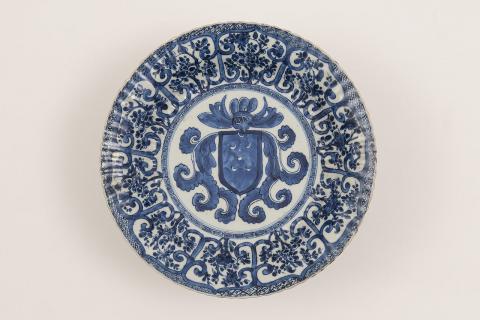Par de Pratos com as Armas “Pinto”
A pair of “Pinto” Armorial Plates
Glazed porcelain
China, Qing dynasty
Kangxi period (1662 – 1722), ca. 1690
Diam.: 27 cm
Prov.: M.F.C. collection, Cascais
Porcelana vidrada
China, dinastia Qing
Reinado Kangshi (1662 – 1722), c. 1690
Diâm.: 27 cm
Prov.: Colecção M.F.C., Cascais
Rare Kangxi period plates of rounded well, fluted lip and waved rim, decorated in cobalt-blue and white underglaze with ‘Pinto’ family heraldry.
In the centre of each plate, framed by a Greek key pattern ring, the Arms of the ‘Pinto’ family from The Hague. On the rim, ten equal canopied ogive panels densely decorated with naturalistic flower stem motifs, the whole composition encircled by an arrangement of geometric grid motifs. On the reverse of the larger plates a decorative detail of three cobalt-blue floral stems and an Artemisia leaf (Ai-Yeh — a symbol for good fortune). The smaller plates with only two similarly arranged motifs.
The armorial is unquestionably that of the ‘Pinto’ family from The Hague and depicts the crest attributed to Manuel Álvaro Pinto (1629 – ?), a Portuguese Jew, forcibly converted to Catholicism, that emigrated to Holland with his family. His grandson Isaac Pinto (1717–1787), a renowned philosopher, would become shareholder and director at the Dutch East India Company (V.O.C.).
For a variety of reasons the correct identification of Chinese porcelain armorials can be challenging. It can sometimes happen that the Chinese painter wasn’t able to replicate the correct original colours, or that the pattern supplied by the client has been unwittingly fantasized, or even that the correct interpretation was impossible because the pattern arrived damaged or discoloured after the long voyage.
In the present examples it is noticeable that the supposedly silvered crescents have been replaced by the brilliant white of the porcelain, and even inverted in one of the smaller plates, while the helmets, mantling and crest of three ostrich feathers, were freely reinterpreted by the Chinese artist.
Independently of the rarity of this extraordinary group of five plates we emphasize the larger pair, for their size, for the exceptional quality of the paste and for the mastery of the painted details.
Identical plates are known in public and private Portuguese and overseas collections such as at the Museu Nacional de Arte Antiga (formerly from in the Alpoim Calvão Collection) and at the Foundation Carmona e Costa (Inv. CER 54A e 54B) both in Lisbon, and at the former Mottahedeh Collection (Cf. Howard and Ayers, p. 63, fig. 17).
Raros pratos em porcelana da China, do período Kangshi, pintados a azul-cobalto e branco sob o vidrado, e decorados com as Armas “Pinto”, com caldeira arredondada, aba direita e bordo recortado, moldado em caneluras.
No fundo, delimitado por cercadura de gregas, estão representadas as armas dos “Pinto” de Haia. A caldeira e a aba são ocupadas por decoração intensa demarcada por painéis ogivais canopiais. Os painéis estão preenchidos com ramos florais e são delimitados na aba por motivos geométricos. O tardoz, nos pratos de maiores dimensões, apresenta, em azul-cobalto, três hastes em flor com folha de artemísia ao centro (Ai-Yeh: símbolo de bom augúrio), e apenas duas hastes também em flor, nos outros pratos.
As armas são, claramente, as dos “Pinto” de Haia que exibem o brasão atribuído a Manuel Álvaro Pinto (1629 – ?), um marrano – judeu português convertido ao cristianismo – que emigrou com a família para a Holanda. O seu neto Isaac Pinto (1717 – 1787), um célebre filósofo, viria a ser accionista e administrador da Companhia Holandesa das Índias Orientais (V.O.C.).
A identificação das armas nem sempre é simples ou porque o artista chinês não usou as cores certas, ou porque fantasiou o desenho fornecido pelo cliente, ou ainda, porque devido à lentidão das viagens as imagens chegavam ao artesão chinês bastante alteradas na sua cor. Estas condicionantes são exemplificadas na representação dos pratos em análise, onde os crescentes de prata são substituídos pelo fundo branco da porcelana, e mesmo invertidos num dos pratos, e os elmos, paquife e timbre de três plumas de avestruz são interpretados à maneira do artista chinês.
Para além da raridade da decoração destes pratos no seu conjunto, chamamos a atenção do par de maiores dimensões, não só pelo seu tamanho, mas também pela grande qualidade da pasta e mestria da pintura.
Existem outros exemplares idênticos em colecções públicas e privadas, portuguesas e estrangeiras, designadamente no Museu Nacional de Arte Antiga proveniente da Colecção de Alpoim Calvão; Na Fundação Carmona e Costa (Inv. CER 54ª e 54B); e na antiga Colecção Mottahedeh (Cf. HOWARD e AYERS, p. 63, fig. 17).
- Arte Colonial e Oriental
- Artes Decorativas
- Porcelanas

